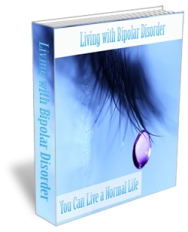|
Bipolar Disorder Guide
Bipolar Disorder Articles
Home
A Bipolar Disorder Checklist to Identify the Symptoms
A Bipolar Disorder Diagnosis is Difficult to Make
A Bipolar Quiz Helps Diagnose if the Disorder is Present
A Bipolar Test Will Identify the Severity of the Disorder
Bipolar Disease Has Many Extreme Levels
Bipolar Disorder in Children Can Present Different Than in Adults
Bipolar Medications Must be Carefully Monitored
Bipolar Symptoms For the Awareness of the Bipolar Disorder
Bipolar Treatment Through Medication and Counseling
Dealing with Bipolar Disorder Takes Time and Patience
The Behaviors of Bipolar Disorder are Disruptive to Everyone
The Chemistry of Bipolar Disorder is an Ongoing Study
The Family Suffers When a Mother Has Bipolar Disorder
The History of Bipolar Disorder Shows It Has Always Existed
The Relationship of Bipolar and Depression
The Types of Bipolar Support Programs That Can Help

CLICK
HERE
To Learn More
Related Links
HealthDuties
|
Bipolar Disorder in Children Can Present Different Than in Adults
Bipolar disorder is a mood disorder that is characterized by
extreme changes in mood, behavior and thinking patterns. The patients suffer from extremes of emotions
that range from high to low. They may be hyperactive at one moment and lapse into depression at another
time. Bipolar disorder in children cannot be identified the same way as with adults.
The manic phase is marked by hyperactivity while the depressive phase results in low energy, excessive grief or
sadness, loneliness etc. Though it was previously believed to affect only older adults, studies and researches have revealed that
bipolar disorder in children is not uncommon. However, it is almost a challenge for psychiatrists and doctors to differentiate
children suffering from hyperactivity and bipolar disorder due to the similarities in the symptoms. But early detection and
diagnosis is essential for proper
treatment to ensure a healthy life for the child. The early onset of the disorder may be
noticed in children diagnosed with depression or attention-deficit-disorder with hyperactivity.
The symptoms of bipolar disorder in children are different from that in adults. While adults may experience
alternative periods of mania and depression, children are likely to exhibit a mixture of emotions at the same time. Regular
intervals of mood disturbances become common. Chronic irritability is noticed in bipolar disorder in children and in
between disturbed moods, phases of wellness can also be noticed.
Some of the common symptoms prevalent in bipolar disorder in children consist of:
- Extremely irritable mood
- Extreme sadness and a lack of interest in playing or other activities that they enjoyed
- Mood swings that can last from a few hours in a day to a few days in a week
- They become defiant towards authority and sometimes become anxious about separation from
parents
- Bed wetting
- Excessive sleep
- Lack of sleep
- Involvement in a number of activities at the same time
- Craving for sweets
- Extreme fits of rage
These are some of the behavioral changes that can be seen in children with the disorder.
Although the DSM-IV criteria is used for diagnosis of bipolar disorder in children, it cannot be taken as a
standard criteria. Various requirements of the criteria cannot be fulfilled in children as the mood swings occur several times in
a day and unlike in adults, there is no clear distinction between the manic and depressive phases.
Lithium, anticonvulsants and atypical neuroleptics are the 3 main types of medication used for treatment of
bipolar disorder in
children. But side effects like excessive weight gain or development of other diseases
such as tardive dyskinesia, polycystic ovarian syndrome etc. can take place. Therefore, children should be well monitored when
they are on medication.
With age the disorder takes on serious dimensions and correct treatment at an early stage becomes necessary to
prevent such phases of mania or depression later in adult life. Bipolar is often related with increased tendency of suicide among
children.
|